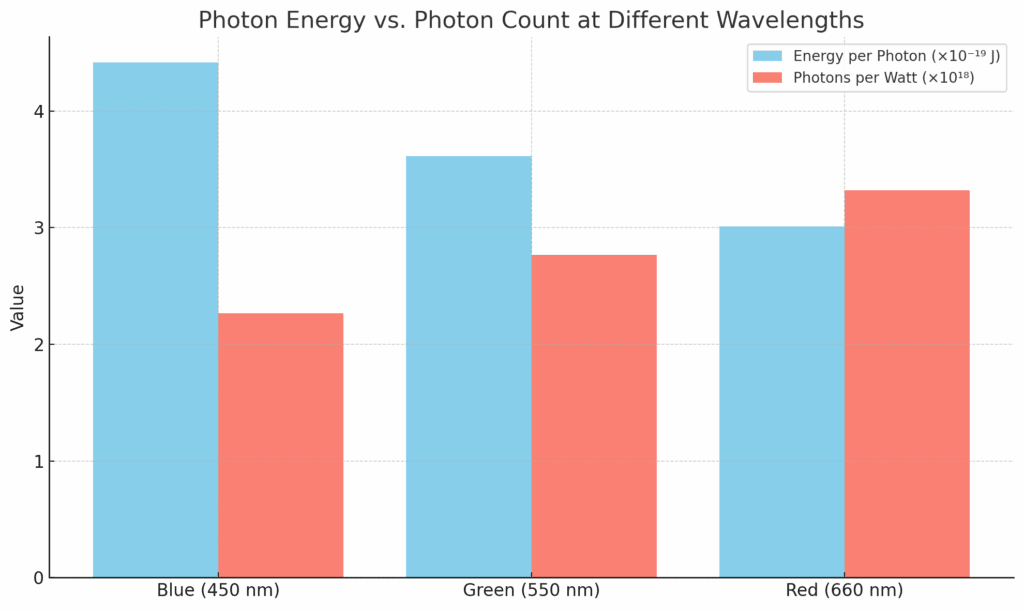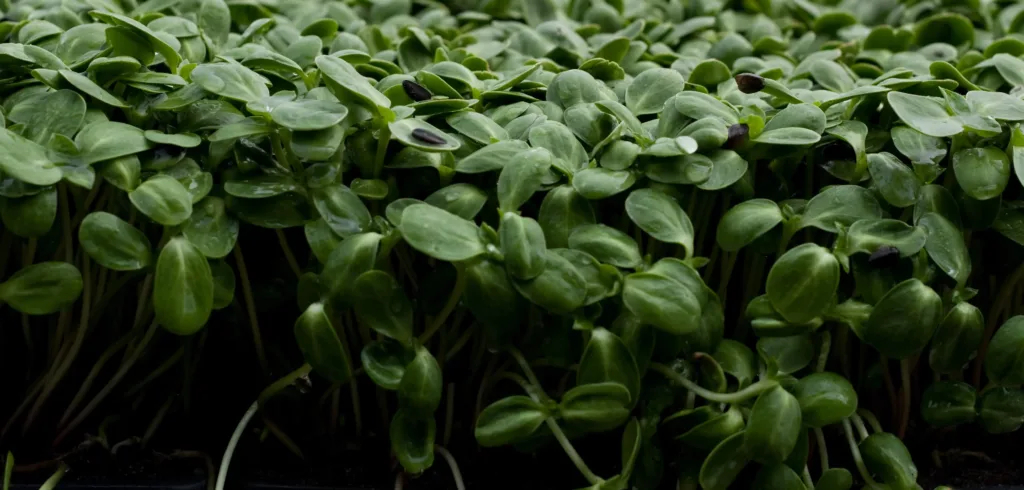In this article, we take a little side trip to explore photons and energy as they pertain to different wavelengths of light and help you better understand the intricacies of lighting spectra
“Blue light has more energy than red—so why do red-rich lights produce better crops?”
It seems backward, but here’s the key:
Plants count photons, not energy. That single idea explains why certain red-leaning light can outperform others—despite blue photons being more energetic.
Let’s walk through this with a microgreens lens.
What Is a Photon?
A photon is a tiny particle of light energy. Blue, green, and red light all have photons, but not all photons carry the same energy. The amount of energy in a photon depends on its wavelength:
- Blue light (~450 nanometers) has shorter wavelengths, so each photon carries more energy
- Red light (~660 nanometers) has longer wavelengths, so each photon carries less energy
This is basic physics:
Shorter wavelength = higher energy per photon.
But for photosynthesis, energy per photon isn’t what matters most.
Microgreens Want Photons, Not Power
Plants don’t “feel” the strength of each photon—they just need lots of them. Microgreens, in particular, are short-cycle crops that depend on dense, even light to grow compact, colorful, and quickly.
That means what matters is the number of photons, which we measure as PPFD—photosynthetic photon flux density.
Let’s look at what happens when we give plants 1 watt of light at different wavelengths:
| Wavelength | Energy per Photon (Joules) | Photons per Second (at 1 Watt) |
|---|---|---|
| Blue (450 nm) | 4.42 × 10⁻¹⁹ | 2.26 × 10¹⁸ photons/sec |
| Green (550 nm) | 3.61 × 10⁻¹⁹ | 2.77 × 10¹⁸ photons/sec |
| Red (660 nm) | 3.01 × 10⁻¹⁹ | 3.32 × 10¹⁸ photons/sec |
Red light gives you more photons per watt—nearly 50% more than blue. That’s why red-rich LEDs are so efficient at driving photosynthesis.
Chart: Energy per Photon vs. Photon Count per Watt
Here’s how photon efficiency works across the spectrum:

This chart shows the tradeoff: blue photons are stronger, but red photons are cheaper to produce in quantity.
Case Study: High-Performing Light
In one of the lights we use for our research (our favourite, to be honest) , we measured the following with our PAR meter:
- Lights: 2 x 31W with built-in reflectors
- PPFD: 176 µmol/m²/s
- Photon distribution:
- Red: 37.5%
- Green: 42.0%
- Blue: 20.5%
- Efficiency: 2.8 µmol/m²/s/W
This is a well-balanced (and efficient!) light for microgreens. Why?
- 20.5% blue is enough to keep growth compact and structured.
- 42% green helps distribute light through the canopy, even to lower cotyledons.
- 37.5% red efficiently drives photosynthesis and biomass production.
- And with a high total PPFD of 176, it delivers enough photons for healthy, fast-growing trays.
This mix explains why that light produces dense, colorful, and quick-harvest microgreens—without legginess or delay.
Understanding Green Light
Green light has long been treated as the “background noise” of plant lighting. For years, growers and even researchers believed that green light was mostly reflected by leaves and not useful for photosynthesis. After all, plants look green, so they must be bouncing it back.
Not quite.
Why Green Light Looks Useless
- Chlorophyll absorbs red and blue light more strongly than green light.
- Green is less efficiently absorbed by the upper layers of the leaf surface.
- To the human eye, this looks like waste: the plant is reflecting green, so it must not use it.
But this is only part of the story.
What Actually Happens to Green Light
While some green light is reflected, a surprising amount of it penetrates deeper into the leaf and even into lower canopy layers. This happens because green light:
- Passes through the outer leaf layers more easily than blue or red
- Reaches photosynthetic cells in inner tissue and lower leaves
- Stimulates photosynthesis in places red and blue often can’t reach
In dense plantings—like microgreens trays—this matters a lot. Green light ensures that more of your crop is photosynthetically active, not just the top layer.
Research Backs It Up
Studies have shown that adding green light to a red/blue-only spectrum can:
- Improve total photosynthesis
- Enhance plant form and coloration
- Reduce photoinhibition from overly strong blue/red exposure
In fact, many high-end white LEDs perform so well because they include a good portion of green light.
What This Means for Microgreens
In our high-performing light references above (with 42% green), green light is doing invisible but important work:
- Supporting even light distribution
- Reaching the cotyledons below the top layer
- Making our lights more comfortable to work under (bonus!)
So while green light might not be the star of the photosynthetic show, it’s a critical supporting actor. Ignoring it entirely leads to shallow lighting and less efficient growth—especially in dense crops like microgreens.
Key Takeaways
- Red light gives you more photons per watt, making it the most efficient for pushing growth.
- Blue light regulates shape and tightness, especially important for seedling structure.
- Green light improves penetration and overall balance, especially under dense canopies.
- Balanced spectrum + high PPFD is the winning combo—exactly what your best-performing light delivered.
- If your trays are stretching under a red-heavy light, you’re probably low on blue.
- If they’re growing tight but slow, you may need more red or overall intensity.

Leave a Reply